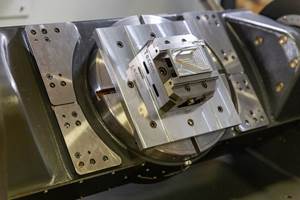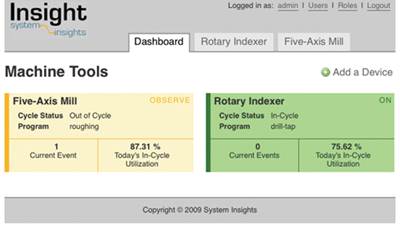The Internet of Things
The push to make manufacturing a fully integrated Internet-of-Things world is gaining momentum
The Internet of Things is a useful catchword that generally refers to the concept that many things can be equipped with intelligent sensing devices that allow them to be monitored, automated or controlled remotely, using the Internet as the communication network. The appeal of this concept is often presented along the lines of this scenario: A Wi-Fi enabled device on your front door will operate the lock to grant entry to pre-authorized family members whose presence is detected as they approach, or to friends dropping by unexpectedly, who you will admit once notified that they are at the door. You may also be notified that the six soft drinks your guests consumed while waiting for your return have triggered a replenishment order that will be added to the weekly grocery order.
Many aspects of current technology for the factory and machine shop already incorporate provisions for remote monitoring, maintenance and control. These advances are already making manufacturing more flexible, productive and convenient. Quality and profitability also get a boost. That said, implementations of this technology are still rather rare, incomplete and somewhat experimental. However, the push to make manufacturing a fully integrated Internet-of-Things world is gaining momentum. For example, Germany’s “Industry 4.0” is a national initiative with this explicit goal. Industry 4.0 is seen as the fourth industrial revolution, one that, in theory, will thoroughly transform manufacturing, based on what proponents there have termed Cyber Physical Systems. The implications are global.
We’ve already seen glimpses of the new shape manufacturing may take. It will be decentralized, highly localized, but broadly distributed. Every machine tool will have the capability to function as an on-demand “mini job shop” serving as a node on a unified, coordinated and integrated manufacturing system. (No doubt some manufacturing assets will be based in our homes.) An online agency is likely to arise to facilitate and regulate the transactions across large branches of this network much the way Amazon, eBay and Google do today in their respective spheres.
Perfecting the sensors and data processing capability to support this revolution will take years.The development and growing implementation of MTConnect, an open, royalty-free set of communications standards intended to foster greater interoperability between manufacturing equipment, is a great headstart. Here’s a critical point—this emerging approach to manufacturing will be consumer-driven. That is, the development will lead to a system in which the consumer or end user will initiate the production of each Thing in the Internet of Things.
Let’s say you decide to upgrade the above-mentioned entry system on your front door. You set the basic specs, or help design this new system. At your signal, a cascade of commands flows to the most appropriate manufacturing assets to machine or mold all of the requisite components, collect them for assembly and ship the finished unit. Hours later, you’ve installed the new device. Cars, appliances and electronic gadgets of all sorts will follow a similar path.
Is this transformation achievable? Inevitable? Advisable? Will it be secure, humane and sustainable? The answers lie within the human spirit.
Related Content
Swiss-Type Control Uses CNC Data to Improve Efficiency
Advanced controls for Swiss-type CNC lathes uses machine data to prevent tool collisions, saving setup time and scrap costs.
Read MoreCan Connecting ERP to Machine Tool Monitoring Address the Workforce Challenge?
It can if RFID tags are added. Here is how this startup sees a local Internet of Things aiding CNC machine shops.
Read MoreDiving Deeper Into Machine Monitoring Data
Data visualization is the first step in using machine monitoring data, but taking it to the next level requires looking for trends within the data.
Read MoreGive Job Shop Digitalization a Customer Focus
Implementing the integrated digital technologies and automation that enhance the customer's experience should be a priority for job shops and contract manufacturers.
Read MoreRead Next
MTConnect Is For Real
Introduced at IMTS 2008, this communications protocol for CNC machines and other manufacturing equipment is already helping shops and plants implement effective machine monitoring systems. Although these "early adopters" are motivated by the long-term promise of enterprise-wide efficiency gains, their experience with pilot projects shows that benefits derived in the short term are substantial and worthwhile.
Read MoreThe Future of High Feed Milling in Modern Manufacturing
Achieve higher metal removal rates and enhanced predictability with ISCAR’s advanced high-feed milling tools — optimized for today’s competitive global market.
Read MoreIMTS 2024: Trends & Takeaways From the Modern Machine Shop Editorial Team
The Modern Machine Shop editorial team highlights their takeaways from IMTS 2024 in a video recap.
Read More























